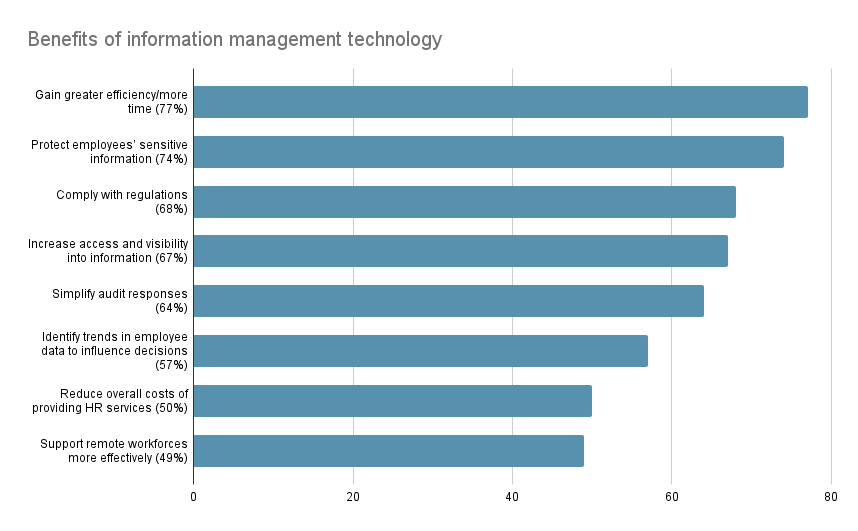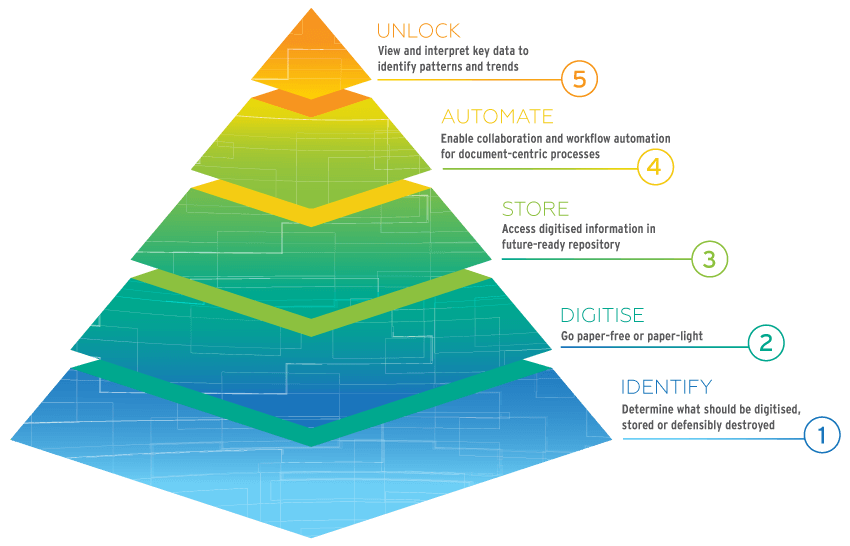5 steps to transform hr information from manual to digital
5 transformative steps that show how HR can benefit by making the switch from manual to digital

From performance appraisals to background checks and healthcare benefits, HR departments manage a lot of information that keeps organisations running. That’s why we found it astonishing that 85% of organisations say their HR information management is not managed sufficiently. Of all the aspects of information management, HR professionals say they want better data security (78%) and data integrity (74%). But how does HR go about accomplishing both of these in an efficient and compliant manner?
Now is the time to make the shift to digitally run systems for all HR information. Based on our co-sponsored research with HR.com, here’s how HR professionals ranked the benefits of using information management technology:

Figure 1. Make HR more efficient/free up time (77%); protect employees’ sensitive information (74%); comply with regulations (68%); increase access and visibility into employee information (67%); simplify audit responses (64%); identify trends in your employee data to influence decisions (57%); reduce overall costs of providing HR services (50%); support remote workforces more effectively (49%)
Here are our five transformative steps that show how HR can benefit by making the switch from manual to digital.

Before you digitise, identify
Ideally, every piece of information that HR touches would be digital. But, did you know 63% of HR professionals still store employee records on physical paper?
If you think a “scan everything” approach to digital transformation is the way to go, you may want to rethink your strategy. To help build your HR department’s digital foundation, we recommend starting off with identifying what to keep, store, and defensibly destroy. This will save your team time and money in the long run.
Because HR teams work with sensitive employee information, their departments have regular information audits—34% occur once a year; 22% get one audit done per quarter. Without a digital way of managing records, these routine audits become much more time-intensive. And the larger the organisation, the more time staff is pulled away from their work to prepare for each audit. From the HR professionals we surveyed, we know 65% believe that implementing information management technology will help simplify audit responses.
By sorting through your legacy HR records, you’re setting your team up for future auditing and workflow success.
All sorted? Let’s get digital!
With no-longer-needed records securely discarded, and the necessary ones ready for scanning, the real transformative work begins. By digitising what’s necessary, you’re part of the 67% of HR professionals who experience better access and visibility into employee information.
Increased visibility into your records helps HR departments better protect employees’ sensitive information. And when that data is secure, 49% of HR professionals agree that it’s much easier to support remote workforces effectively.
With digital employee records, you’re taking one step toward helping HR professionals be more productive. They’re not sifting through old file cabinets or driving to an office across town to find a particular record. Further, eliminating most of your physical paper also frees up real estate in the office.
Finding the right digital storage
Everything that needs to be in a digital format has been sorted and all the necessary documents have been scanned. Now, your HR Department gets to choose how best to store its digital records.
And what’s good for some may not be good for others—it all depends on what industry your organisation serves. You could have an industry that requires higher security levels or strict retention policies that impact your digital record storage choice. An astonishing 69% of HR professionals say their employee records could be made more secure. Given the amount of HR records still in physical paper format, this isn’t surprising.
Because protecting employees’ sensitive information is crucial, how you store these newly digitised records is important, and you have options:
- On-premises
- Colocated data centres (offsite)
- In the cloud
- Archived storage
So we recommend storing those employee and business critical documents in a secure information management and content services platform with role-based access controls for global employees. This allows for a more centralised and secure digital repository that stores your digital records with the single source of truth for employee data, integrates with common business applications across functional silos, and enables process automation.
How automation can alleviate labour-intensive hr tasks
Great! You’ve come this far in your digital journey but you’re not done yet—the real transformation starts now. Without implementing automation capabilities, you may be missing out on time-saving workflows and processes.
Automating document-centric work tasks helps reduce manual processes. In fact, 77% of respondents from our co-sponsored research confirm that a key advantage to adopting technology is the ability for HR to free up time and to make its processes more efficient.
Putting an automation system in place for your newly digitised HR records allows for easy and up-to-date application of record retention and policy management. Our research shows 66% of HR professionals have retention rules for employee identifiers and only 55% agree that HR disposes of sensitive data in a timely manner. But 68% of HR professionals say information technology, like automation, helps to comply with regulations. Think about how often laws and regulations change around the world and what HR professionals need to update to keep their organisations in compliance—automation can solve for this.
So if you want to truly improve information management overall, automation is a necessity.
Information is power - Let’s unlock it
Yes, there’s one more level to go in the digital transformation of your HR records.
Even though you’ve automated several mundane processes, information technology still has more to offer. With 57% of HR professionals saying it helps identify trends in employee data to influence decisions, applying analytics for added insights is our last step.
By incorporating analytics into your records management processes, your HR team can more easily see what’s working and what’s not working, and help you decide what to focus on. We believe, as do 50% of HR professionals, that information technology like this will help reduce overall costs to your organisation.
Going through these five steps of digital transformation with a trusted vendor who can do it all helps your HR team more quickly implement change and streamline its work. If your team decides it wants to use multiple vendors, you risk falling into old patterns where walled off pieces of information could creep up. By choosing one vendor for this process, you’ll ensure your HR team can manage and access all its pertinent information in one centralised source of truth.
Related resources
View More Resources
InSight Digital Experience Platform (DXP)

